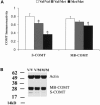Functional analysis of genetic variation in catechol-O-methyltransferase (COMT): effects on mRNA, protein, and enzyme activity in postmortem human brain
- PMID: 15457404
- PMCID: PMC1182110
- DOI: 10.1086/425589
Functional analysis of genetic variation in catechol-O-methyltransferase (COMT): effects on mRNA, protein, and enzyme activity in postmortem human brain
Erratum in
- Am J Hum Genet. 2005 Jun;76(6):1089
Abstract
Catechol-O-methyltransferase (COMT) is a key enzyme in the elimination of dopamine in the prefrontal cortex of the human brain. Genetic variation in the COMT gene (MIM 116790) has been associated with altered prefrontal cortex function and higher risk for schizophrenia, but the specific alleles and their functional implications have been controversial. We analyzed the effects of several single-nucleotide polymorphisms (SNPs) within COMT on mRNA expression levels (using reverse-transcriptase polymerase chain reaction analysis), protein levels (using Western blot analysis), and enzyme activity (using catechol methylation) in a large sample (n = 108) of postmortem human prefrontal cortex tissue, which predominantly expresses the -membrane-bound isoform. A common coding SNP, Val158Met (rs4680), significantly affected protein abundance and enzyme activity but not mRNA expression levels, suggesting that differences in protein integrity account for the difference in enzyme activity between alleles. A SNP in intron 1 (rs737865) and a SNP in the 3' flanking region (rs165599)--both of which have been reported to contribute to allelic expression differences and to be associated with schizophrenia as part of a haplotype with Val--had no effect on mRNA expression levels, protein immunoreactivity, or enzyme activity. In lymphocytes from 47 subjects, we confirmed a similar effect on enzyme activity in samples with the Val/Met genotype but no effect in samples with the intron 1 or 3' SNPs. Separate analyses revealed that the subject's sex, as well as the presence of a SNP in the P2 promoter region (rs2097603), had small effects on COMT enzyme activity. Using site-directed mutagenesis of mouse COMT cDNA, followed by in vitro translation, we found that the conversion of Leu at the homologous position into Met or Val progressively and significantly diminished enzyme activity. Thus, although we cannot exclude a more complex genetic basis for functional effects of COMT, Val is a predominant factor that determines higher COMT activity in the prefrontal cortex, which presumably leads to lower synaptic dopamine levels and relatively deleterious prefrontal function.
Figures








References
Electronic-Database Information
-
- Mammalian Gene Collection, http://mgc.nci.nih.gov/
-
- Online Mendelian Inheritance in Man (OMIM), http://www.ncbi.nlm.nih.gov/Omim/ (for the COMT gene)
-
- Software and Course Materials, http://www-gene.cimr.cam.ac.uk/clayton/software/
References
-
- Ahsan H, Chen Y, Whittemore AS, Kibriya MG, Gurvich I, Senie RT, Santella RM (2004) A family-based genetic association study of variants in estrogen-metabolism genes COMT and CYP1B1 and breast cancer risk. Breast Cancer Res Treat 85:121–131 - PubMed
-
- Ailenberg M, Silverman M (1997) Site-directed mutagenesis using a PCR-based staggered re-annealing method without restriction enzymes. Biotechniques 22:624–626, 628, 630 - PubMed
-
- Axelrod J, Tomchick R (1958) Enzymatic O-methylation of epinephrine and other catechols. J Biol Chem 233:702–705 - PubMed
-
- Badner JA, Gershon ES (2002) Meta-analysis of whole-genome linkage scans of bipolar disorder and schizophrenia. Mol Psychiatry 7:405–411 - PubMed
-
- Boudikova B, Szumlanski C, Maidak B, Weinshilboum R (1990) Human liver catechol-O-methyltransferase pharmacogenetics. Clin Pharmacol Ther 48:381–389 - PubMed
Publication types
MeSH terms
Substances
LinkOut - more resources
Full Text Sources
Other Literature Sources
Medical
Miscellaneous

